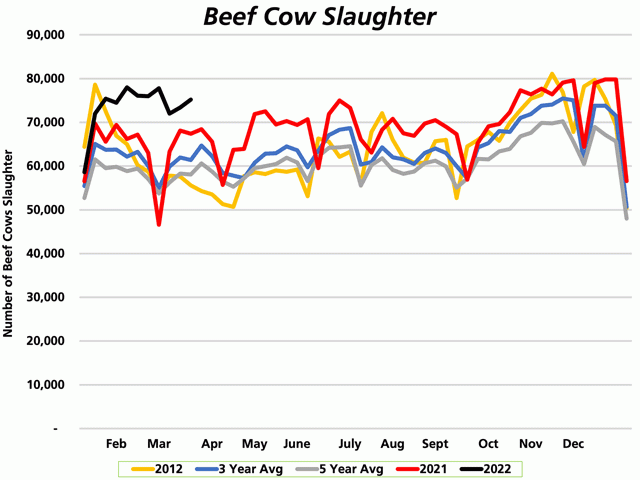Call the Market
Cows Head to Town While Markets Focus on Grains, Russia
I hate to say it, but I almost wish the cattle market a season of boringness. The last three years have been anything but ordinary, and as time passes us by, its looking like 2022 is going to have plenty of noteworthy marks itself. From continued labor issues in packing plants due to the omicron COVID-19 variant in January, to the Russian invasion of Ukraine and skyrocketing grain prices in February to a bolstering Cattle on Feed report in March, month by month there's always something new. One constant, however, that's remained since 2021 is the rapid pace that beef cows are being processed.
I don't share this data with you to flame the burning need of moisture but rather to help producers juggle the nearby hiccups of the market to the long-term cycle that we're about to enter.
P[L1] D[0x0] M[300x250] OOP[F] ADUNIT[] T[]
In 2021, there were only 18 weeks when the market processed over 70,000 head of beef cows in a week's time, but thus far in 2022, there's only been one week when the market has not processed over 70,000 head of beef cows in a week.
As the market continues to change and adapt to the rising cost of feed, the unknown certainty of moisture and the added pressure to ranchers' bottom lines, more cows have hit the market and ended up as hamburger than most realize.
If cattlemen do not realize and understand the cause-and-effect relationship between drought and cowherd liquidation, they could be in for a costly ride. To date, the market has processed 15% more beef cows in 2022 than it had at this time in 2021. This year has processed 27% more beef cows year to date than compared to the five-year average. If we compare 2022 to 2012 (because of the server drought that the Southern half of the country endured in 2012), the market has processed 17% more beef cows at this time in 2022 than what it had in 2012.
There's no one-size-fits-all solution to persevering drought. Some ranchers will have feed that they can rely upon to get them through this season and into the next, and others won't have any other option but to load up trucks and send their cows to town. However, just as it's important to realize what needs done in the present, if producers' long-term plan is to continue to run cows, then they cannot afford to be caught off guard by the rippling effects of cowherd liquidation and drought.
ShayLe Stewart can be reached at ShayLe.Stewart@dtn.com
(c) Copyright 2022 DTN, LLC. All rights reserved.




